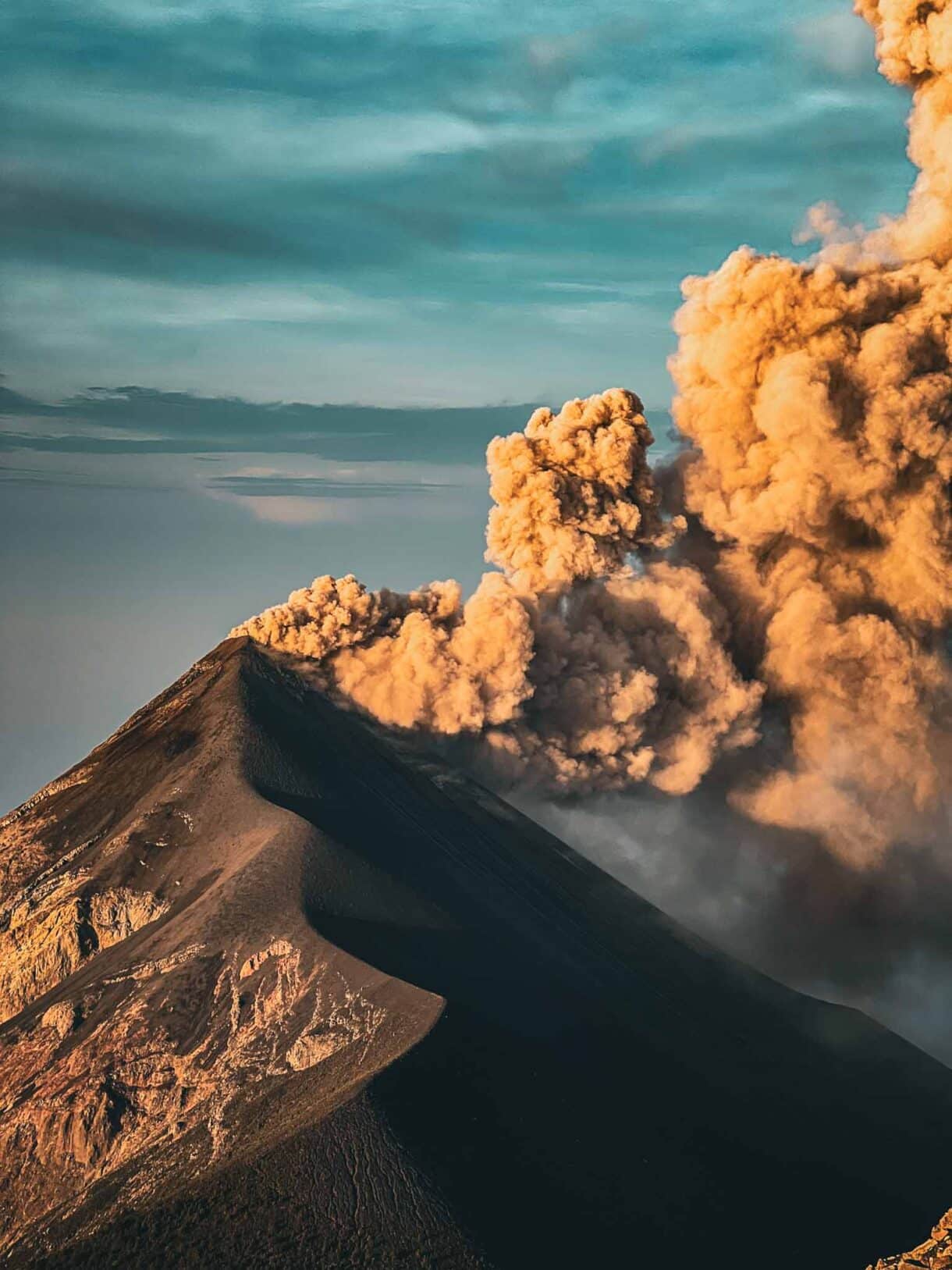
The ULTIMATE guide to the overnight Acatenango Volcano hike, Guatemala [2024]
Have you ever wanted to sit around a campfire, hot chocolate in hand, whilst watching an active volcano send sparks and lava into the air? Well, now’s your chance! The Acatanengo volcano hike in Guatemala is a real thing that you can do and it definitely needs to be added to your bucket list!
The Acatenango Volcano hike is one of the most amazing experiences you’ll have in Guatemala, and even the whole of Central America. And you don’t even need to be super fit to do it! Here, we’ll cover everything you need to know, and everything we wish we’d known, about hiking Acatenango Volcano. So, keep reading for the ULTIMATE guide to the the Acatenango Volcano hike (it’s more in-depth than anywhere else, we’ve checked!)

A guide rests on the summit of Acatenango
We knew before we even set foot in Guatemala that hiking Volcan Acatenango was a non-negotiable activity during our Central America adventures.
But there are so many volcanoes in Central America! Why did we want to hike this specific one?
Well, Volcan Acatenango lies directly next to Volcan de Fuego. Fuego is Central America’s most active volcano, with low-level (non-dangerous) eruptions every 10 to 15 minutes.
The chance to see Volcan de Fuego erupt, sprinkling sparks like stars across the dark night sky before sending lava cascading down through the clouds below, was a once-in-a-lifetime opportunity. It was an experience that we weren’t willing to miss.
Preparation is the key to success! Keep reading for the Ultimate guide to the Acatenango volcano hike. Start here, at the beginning. Or skip to any of the contents below for instant answers to your burning volcano questions (because this guide is as long as my Masters thesis… no joke).
CONTENTS:
We’ll cover what, and where is Volcan Acatenango, and why you’d want to hike it! After that, we’ll let you know all about the hike and what to expect. And we’ll finish up with the logistics; how to find a guide, what to pack, what to expect from the weather and altitude, and how fit you need to be to hike Acatenango.
Click on any of the links below to be taken to that section.
ABOUT ACATENANGO:
A TYPICAL ACATENANGO HIKE ITINERARY
FACILITIES & ACCOMMODATION
GUIDES: EVERYTHING YOU NEED TO KNOW
WEATHER AND ALTITUDE
WHAT TO WEAR & PACK FOR THE ACATENANGO HIKE
WHAT TO WEAR & PACK FOR THE ACATENANGO HIKE
OTHER…
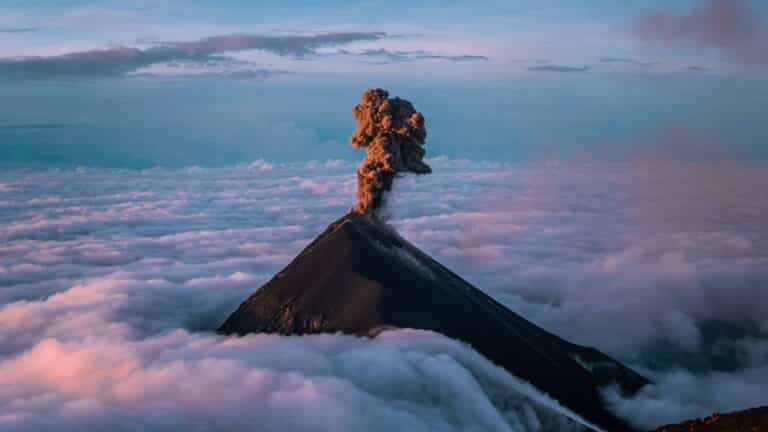
Fuego from the summit of Volcan Acatenango
WHAT, AND WHERE, IS VOLCAN ACATENANGO?
Sitting in the Sierra Madre de Chiapas, Volcan Acatenango is a stratovolcano in Guatemala. This conical volcano is built up by many layers of hardened lava and tephra. At 3976 meters high, Acatenango is the third-highest peak in Central America (all three are in Guatemala).
But Acatenango itself isn’t very special – no. more so than your average Central American volcano. When people say that they’re going to do the Acatenango volcano hike what they really mean is that they’re hiking to see its smaller, very active, and appropriately named neighbour, Volcan de Fuego (Volcano of Fire).
Volcan de Fuego is the most active volcano in Central America. This volcano has low-level eruptions daily, sending smoke, sparks, and copious amounts of lava into the air.
Watching Fuego erupt over and over again will likely be the coolest and most insane thing you’ll ever see in your life. But nothing easy is worth having. You have to work for this incredible view with a pretty strenuous two-day hike.
WHY DO THE ACATENANGO VOLCANO HIKE IN GUATEMALA?
Hiking to the base camp of Volcano Acatenango gives you a direct view over ‘Volcan de Fuego’ which is the most active volcano in Central America.
Living up to its name, which translates to Volcano of Fire, Fuego sends ash plumes into the air roughly every 15 minutes. At night, Fuego will light up the sky with sparks, and send burning rocks and lava soaring through the sky and crashing down onto the slopes.
The Acatenango volcano hike remains one of our most challenging yet rewarding hiking experiences to date. There were times when I was really close to giving up.
But I’m so glad I didn’t!
The reward of camping on top of an active volcano while watching another highly active volcano spit fire was definitely worth the effort! You’ll get to watch the sun splash its evening orange colours across the sky, and watch it rise again in the morning as volcanoes poke their summits through a sea of pink clouds.
The Acatenango Volcano hike was the best thing we did in Guatemala and one of the highlights of our whole Central America trip! Above the clouds, you’ll feel a million miles away from the hustle and bustle of Latin America. It’s worth all the leg pain afterwards, we promise!
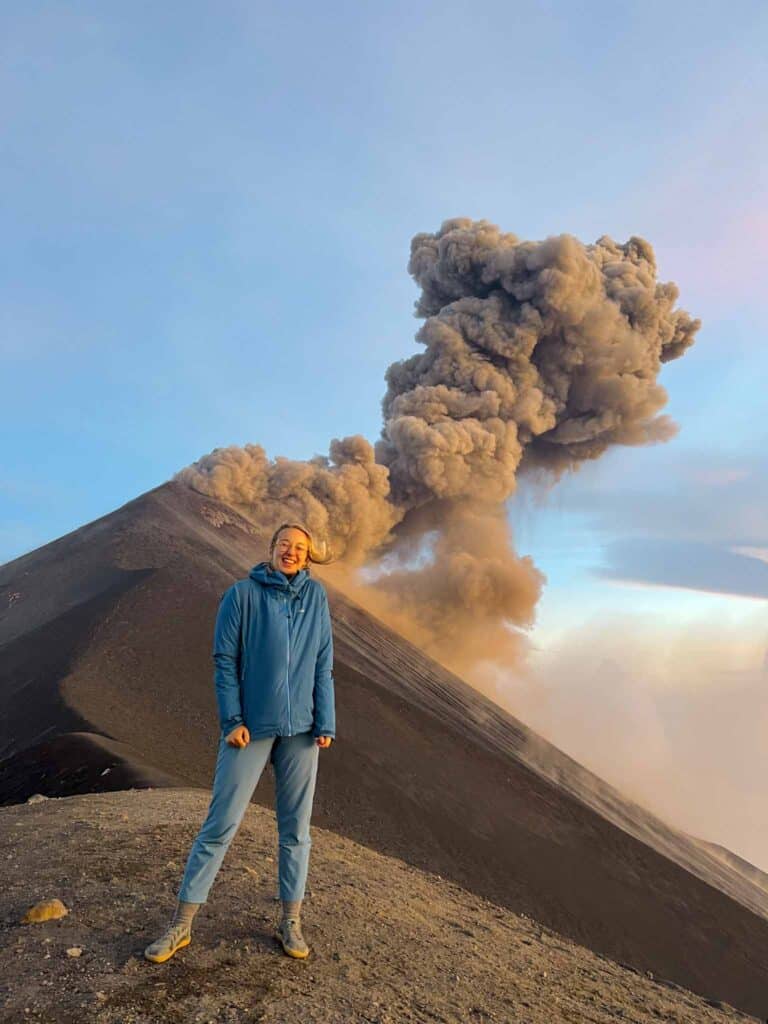
Pure excitement! These views can be yours on the Acatenango Volcano Hike, Guatemala!
OVERNIGHT ACATENANGO VOLCANO HIKE: THE TYPICAL ITINERARY
DAY 1:
#1 PICK UP SUPPLIES & TRAVEL TO ACATENANGO
Each company does their Acatenango Volcano hike differently. You’ll most likely be picked up from Antigua in a minibus. The drive to the trailhead takes around an hour, maybe a little more.
You might have a briefing on the way to the Acatenango volcano hike trailhead, you might not. Either way, you’ll usually arrive at the trailhead around 9 am to 10 am ready to start walking.
We did our Acatenango volcano hike with V-Hiking tours. They picked us up at 7am from Antigua, earlier than most tours would offer. Then they drove to their hostel in San José Calderas, a small village at the foot of Acatenango. Here, we had a delicious home-cooked Guatemalan breakfast of fried plantain, beans, eggs, bread, and veggies! It was the perfect way to fuel ourselves for the hike ahead, and we also had the chance to rent gear here as well.
#2 HIKE TO BASE CAMP
It sounds so easy condensed into four words. So simple.
But it’s actually really tough!
It can be quite hot at the trailhead, and the hike on the first day is entirely uphill. As you start hiking, you’ll begin to see the groups who set off the day before coming back down.
They’ll all tell you that the first few hours are the most difficult and that the route will get easier. But it’s not really the route that’s the problem, it’s the altitude. The route won’t get easier until the last 45 minutes before base camp. But your body will acclimatise and you’ll stop feeling so dizzy and out of breath after the first hour or so. That’s something at least!
It’s about five to six hours from the trailhead to base camp, but that also includes snack and water breaks. Your first stop will be around 20 minutes in, at a set of wooden huts selling snacks and drinks. You’ll stop again at the park entrance, where you’ll need to fill out your entry form. After that, where your team stops is up to you!
We set off at 10 am and arrived at base camp around 3pm – so around 5 hours of hiking in total. Our group was super chatty, which I was grateful for. I saw a lot of groups walking silently, headphones in, staring at the pair of boots in front of them. But it was nice to have a group where we could swap stories, share recommendations, and help each other organise our onward travel plans!
#3a RELAX AT BASE CAMP...
Once you arrive at base camp, you can collapse into a chair or a hammock and watch the magic begin! Fuego will (hopefully) erupt fairly regularly, sending smoke pluming into the air. All of a sudden, you’ll see why hiking Acatenango was worth all the pain.
It gets better! As the sky begins to darken, you’ll see sparks scatter across the sky and explode into the darkness like orange fireworks. This is followed by a huge bang as rocks hit the ground and roll down the sides of Volcan de Fuego.
You have to make sure you’re watching though. Sound travels slower than light, which means that by the time you hear the eruption, the show is mostly over.
#3b ...OR OPTIONAL FUEGO CLIMB
The Fuego hike has an add-on cost of ~200Q ($25 USD), but can be upwards of $40 USD with some tour companies! You can only do this trek a) if the weather is good, and b) if enough people from your group want to join you. For our group, the minimum was 3 hikers.
The hike to Fuego is tough. It’s in a V shape, and involves 300 metres of descent followed by 300 metres of ascent again. Double that for the way back, and you’re looking at 2+ hours of hiking and 600 metres of elevation on top of the 1550 metres that you’ve already ascended today.
After you’ve made it to base camp, you’ll collapse, either into a chair or onto your bed. You’ll reach for your warm layers, bundle up, and a mug of steaming cocoa will be pushed into your freezing cold hands.
You’ll have a lovely warm campfire with a perfect view of Fuego erupting in the background. Maybe there’ll even be cookies or marshmallows. You will be warm, cosy and enjoying the very thing you came to see.
You will not want to get up, put your hiking boots back on, and walk for another two hours.
This is the wrong choice. Hear me out and I’ll explain why in a minute.
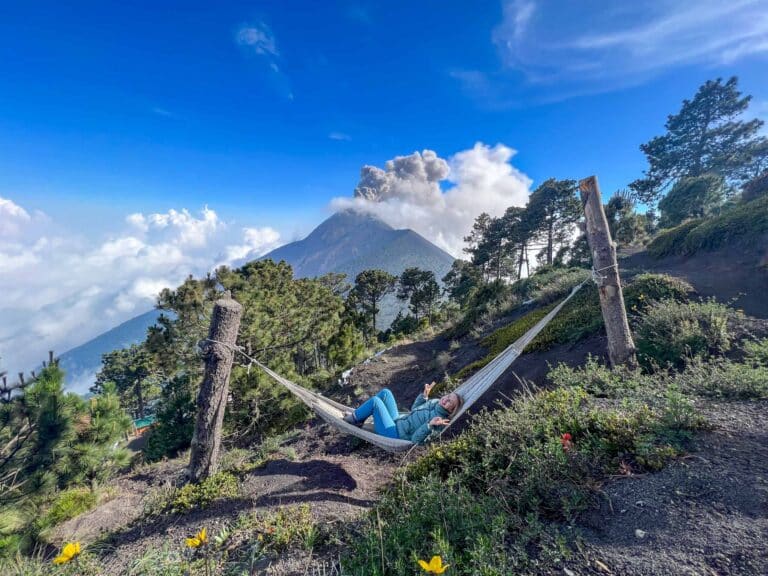
How many hammocks have views like this?
DAY 2:
#4 SUMMIT CLIMB FOR SUNRISE
The summit of Acatenango is really exposed and, like any mountain, this can be quite dangerous if the weather is bad. Your guides will wake up at around 3 am and check the weather conditions. If it’s looking alright, they’ll wake the group. Roll into your hiking boots and strap on your head torch for a 3:30 am start.
Climbing to the summit can take up to 90 minutes. Although it’s only 300 metres in elevation above base camp, the hike is straight upwards, the loose volcanic terrain is slippery, and your legs will ache from the day before. It’s hard work.
As you hike, you’ll see the sun rising behind Volcan de Agua. The name translates to Water Volcano – we think she’s the perfect pair to Fuego! We had the most beautiful cloud inversion on our summit hike, paired with an appearance from Agua, and a sun ready to light up the whole world.
The ascent to the summit is also optional and you can just as easily watch the sunrise from base camp. But if you’ve come this far, you might as well go up to the top, right? Don’t forget to look back and see Fuego lit up against the dark blue sky.
Top tip: Wear all the clothes you have with you. It’s bitterly cold and windy at the top, where you’ll want to sit and watch the sun rise.
#5 RETURN TO CAMP
Luckily, the loose volcanic terrain makes getting down a breeze. You can slip and slide your way back to base camp in 15 to 20 minutes.
Top tip: the best way to get back to base camp is to give into the force of gravity and run down. You can also get down with a sort of bum-shuffle which is pretty fun!
Once you’re back, it’s time for breakfast and packing up your things. Take your time over breakfast. Soak up the final views of Fuego, and take a moment to be in the here and now. You’ll be walking with your back to the eruptions all the way down.
Remember, what goes up must come down, including your rubbish! Bring it back to the trailhead where it can be disposed of properly.
#6 HIKE DOWN ACATENANGO
Remember that gruelling 5 hour uphill slog from yesterday? Well, although the distance may be the same, the way back down takes half the time. The first 45 minutes are fairly flat, before the trail gets steeper again.
Head down at your own pace. This part of the hike can be hard on your knees, and we really recommend taking your time, as the trail can be slippery. I think everyone in our group slipped at least once! This is where it’s really handy to have proper hiking shoes and walking poles.
As you get nearer to the road, you’ll pass the people heading up Acatenango. They’ll be less than an hour into their trek, with fresh faces and excited smiles. “Keep going”, you can tell them “It gets easier after the first couple of hours”.
Because you woke up so early, you’ll finish this hike nice and early at around 11 am. The group will meet at the minibus by the roadside. There are a couple of wooden shacks here selling snacks and drinks. Grab an ice-cold can of soda whilst you wait for the rest of your group – you’ve surely earned it!
#7 RETURN TO ANTIGUA
Some companies will take you straight back to Antigua, some will take you via their office or equipment hub. We went back to the V-Hiking headquarters to drop off our rented equipment and enjoy a freshly-squeezed juice and some homemade biscuits.
Either way it won’t be long before you’re enjoying a warm shower and a comfortable bed!
Most of us napped on the hour-long ride back to Antigua, where we were dropped back at our hostels. We’d only left the day before, but it felt like we’d been gone for ages!
Some companies also offer direct transport to Lake Atitlan from the trailhead of Acatenango. It didn’t seem to save any money, but such a journey could save you time if you are planning to go there anyway.
Top tip: Why not treat yourself to a nicer-than-usual accommodation in Antigua? We usually book cheap hostels. It’s just a place to rest our heads after a long day of adventures, we don’t need anything fancy! But we can guarantee that you won’t want to do much for the rest of the day after your Acatenango volcano hike and you’ll probably just want to nap and laze around. We don’t blame you! And where better to do that than a hammock in a nice hostel?
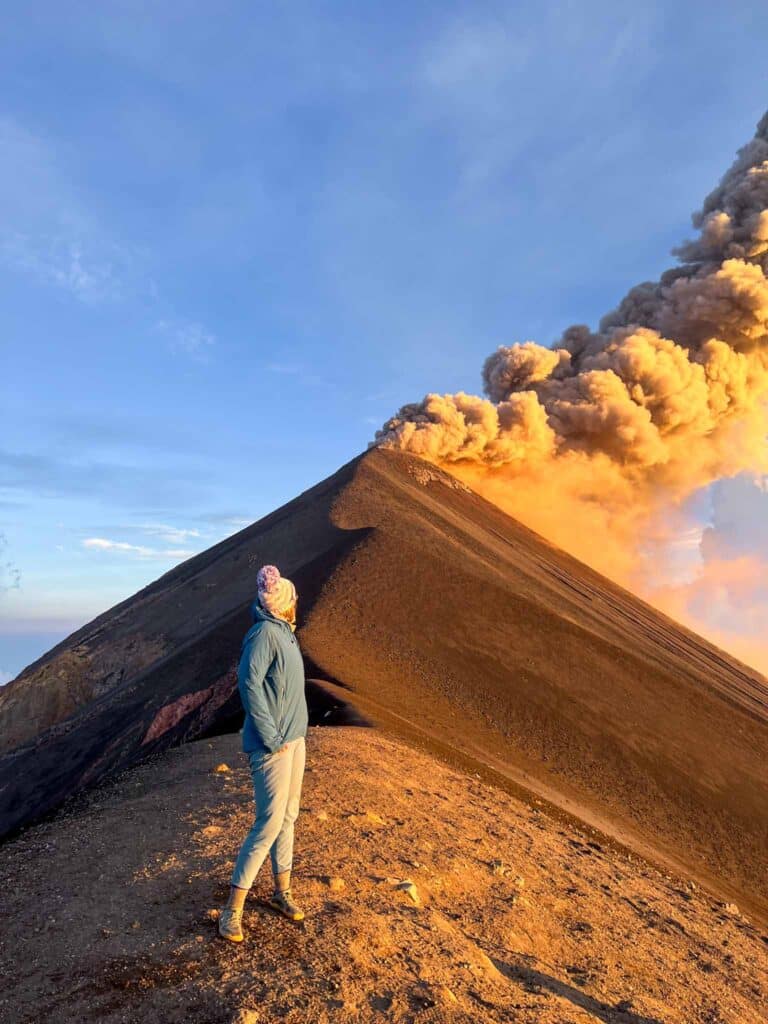
Less than 900m away from an erupting volcano on the optional Fuego hike.
IS THE OPTIONAL HIKE TO GET CLOSER TO FUEGO WORTH IT?
Volcan Fuego is the star of the show. The main attraction, the one you’re hiking towards, the reason you’ve dragged yourself up the side of one volcano and are considering whether you can make your legs move towards another despite exhaustion setting in the minute you reach base camp.
Once you sink into your oh-so-comfortable plastic chair at base camp, you will not want to get up again. Your guides will pass around hot chocolate and cookies. There’ll be marshmallows for toasting and, after a couple of hours, your legs will begin to ache from the day’s hiking.
But, when your guides offer the chance to get closer to Volcan de Fuego for sunset, take it.
This part of the hike was the best part of the entire trip. It was the ‘wow’ moment. The views were so much better than the views from base camp. Better, even, than getting up at 3:30 am to see the sun rise from the top Acatenango.
Fuego erupts very regularly, approximately once every 15 minutes (although it’s common to have several eruptions in a short space of time). On the optional Fuego hike, you’ll be less than 900 metres from these eruptions. You’ll be so close, you’ll feel the ground shaking.
After the sun sets, you’ll be in the perfect position to witness the bright orange lava spewing out into the sky and tumbling down the side of Volcan de Fuego.
Note: It’s not uncommon for many of the Fuego hikers to be too tired for the Acatenango summit hike at 3:30am. Although the sunrise hike to the summit is the purpose of the entire trip, we still thought the Fuego hike was more impressive! And we made it to the Acatenango summit too – it is possible!
IS IT GUARANTEED TO SEE LAVA?
The burning question! (pun intended)
As with anything in nature, nothing is certain, and everything is out of control. Fuego had had a bigger-than-usual eruption during our time in Central America… followed by quiet. We’d heard from travellers coming down from Guatemala that Fuego wasn’t erupting at all.
Was it even worth the hike?
Well, we weren’t lucky enough to see the classic ‘lava fountain’ that Fuego is so famous for. But we still got some epic plumes of smoke, a spark-lit sky, and some lava, which was visible against the night sky.
I’d never seen a volcano erupt before, and I was so satisfied with what we saw. Especially on the optional Fuego hike, which blew my mind!
It’s also important to remember that a lot of the photos of Fuego that have ‘lava’ (like the example below) are taken using professional camera equipment. Photographers use long-exposure to capture multiple eruptions in a short space of time, and what looks like lava is often just a long-exposure shot of hot rocks being thrown out of the top! We say this so that you don’t have unrealistic expectations – just in case Fuego doesn’t feel like putting on a show for you!
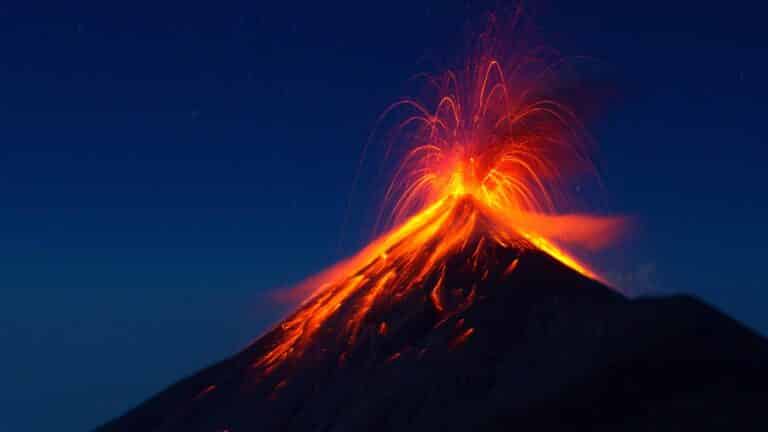
Long exposure photography of Fuego
WHAT TO EXPECT ON THE OVERNIGHT ACATENANGO TOUR
FACILITIES: WHAT TO EXPECT AT ACATENANGO BASE CAMP
Each company has their own base camp area with similar facilities. There are a couple of things in common: no electricity, no showers and no WiFi at base camp.
Most of us can go without a shower for one night at least, so the lack of showers isn’t really a problem. It’s bloody freezing up there anyway, so you won’t want to take your jumper off, never mind the rest of your clothes!
The lack of WiFi isn’t really a problem either. You’ll be too busy chatting with your new hiking buddies and watching Fuego erupt to even think about checking in on social media. Save it for when you’re back down. If you have relatives who worry, remember to let them know you’ll be off-grid for a couple of days.
If you need to charge your phone or camera, we recommend bringing a fully-charged battery pack. There’s no electricity at base camp and you don’t want to miss out on epic photo opportunities because your phone ran out of battery!
Top tip: At high altitudes or cold temperatures, we like to sleep with our phone in our sleeping bag or under our pillow. Why? The cold temperatures massively drain the battery (iPhones are really bad for this!) which can make your phone shut off and refuse to start.
ACCOMMODATION: WHAT TO EXPECT AT ACATENANGO BASE CAMP
There are two main options for sleeping: tents or cabins.
Different tour companies have different options, so you’ll need to pick a company based on your preferred accommodation.
Tents are the cheaper option. The tents are usually two-person tents, which is perfect if you don’t like to share with strangers. You have a little more privacy as you will only be sharing a sleeping space with your travel buddy (or you can have a tent all to yourself!).
However, they’re generally a bit colder and not very spacious. When the cold set in, I was grateful for the body heat of my travel buddy.
Cabins are slightly more expensive, but not by much! They’re more solid, so you’ll be protected from the elements. You’ll also get a proper mattress to sleep on (although you won’t get many hours of sleep on this hike!) and mountains of bedding, sleeping bags, blankets, you name it!
The cabins are also shared between two people – great for us, as we were travelling together. If you’re travelling alone, you may be able to have a cabin to yourself but you might be asked to share with a stranger. Then again, after spending all day hiking together, you won’t exactly be strangers any more.
Most camps also have a campfire and an area to sit, eat and socialise.
Our camp had hammocks to chill out in, and plastic chairs to sit on for meals. Other travellers have reported that they were sitting on logs or on the ground. If this is something you care about, it might be good to check with your tour operator.
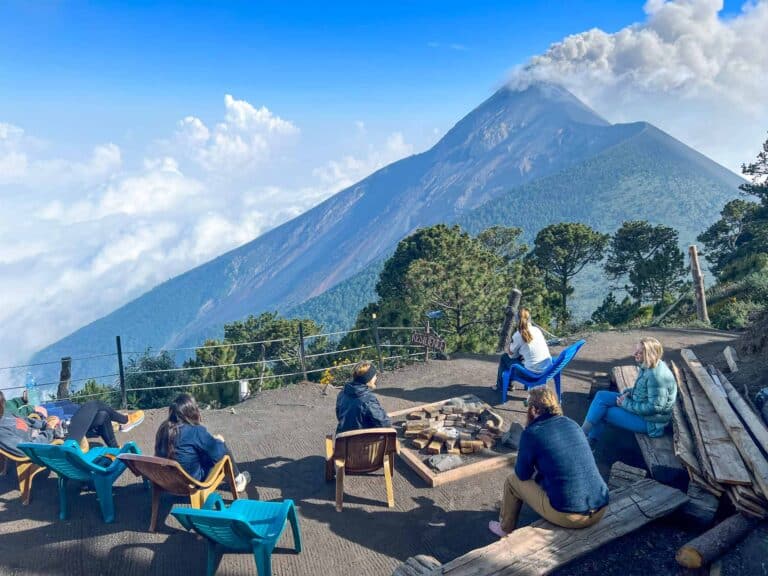
What to expect from your camp: an excellent view of Fuego!
MY HONEST REVIEW OF THE ACATENANGO VOLCANO HIKE
The Acatenango volcano hike in Guatemala isn’t just a hike for your Guatemala bucket list. It should be on your ultimate bucket list. The list of things to absolutely do before you… y’know… kick the bucket. Feeling the formidable force of nature as Fuego erupts directly in front of you, shaking the ground and sending birds flying from trees, is something you need to experience.
I’m not going to sugar coat it, this was a hard hike. I approached it with a somewhat cocky attitude (very unlike me, I know). I’ve done multi-week treks in Nepal’s Himalayas, hiked the highest mountain in Morocco, and just a couple of months prior, trekked the Inca trail and Rainbow Mountain – both high-altitude hikes in Peru. Plus, we hike regularly at home in Scotland! I thought it would be a breeze.
But after struggling uphill for five hours, plus an extra three hours to hike closer to Fuego, I was worried I wouldn’t make it up to the top of Acatenango the next morning! The altitude was taxing, and the weather wasn’t great – it was a little drizzly and we had some clouds.
That said, nothing worth having comes easy, and it was worth the pain to make it to the top. As the sun set, Fuego treated us to a spectacular display of smoke and sparks, a testament to the raw power of nature. Camping so far away from any major settlement meant that the stars came out once it got dark, and we sat around a campfire sipping hot chocolate and swapping stories. You’ll forget the leg pain and steep uphill struggle. But the feelings you experience whilst watching Fuego erupt will stay with you forever.
Would I do it again? 100% yes.

The sun setting from the Fuego hike. Literally, floating on clouds!
ACATENANGO HIKE: GUIDES & TOURS
DO I NEED A GUIDE TO HIKE ACATENANGO?
Well, there’s no rule that says you can’t do this hike by yourself. But, unless you know the route, have all your own gear, and have experience hiking and camping at altitude, I’d strongly recommend hiring a guide for the Acatenango Volcano hike in Guatemala.
Doing the hike with a guide is safer and easier. All of the logistics are handled for you. The tour companies usually have tents/cabins and cooking facilities set up at the base camp already. They’ll provide gear, like extra clothing and sleeping bags, and they’ll arrange your pickup and dropoff in Antigua
Add all of that up, and doing this without a guide probably won’t save you any money!
We also want to encourage travellers to give back to the communities they visit. Supporting local communities is a great way to contribute to the local economy and be a responsible tourist. Keep reading for the best companies for your Acatenango volcano hike.
CAN I HIKE ACATENANGO BY MYSELF?
We get it. There’s something very rewarding about hiking without a guide. It’s just you and the nature, and you can experience everything in your own time. But please don’t do this hike without a guide unless you are very experienced and have the right equipment.
Inexperienced solo travellers have died from attempting Acatenango alone. Why take the risk? Here’s why we wouldn’t recommend hiking Acatenango without a guide:
- Guided tours are very affordable, prices start at $50 USD
- The trail isn’t well marked. Unless you know where you’re going, it’s easy to get lost!
- It doesn’t save you any money to do it alone. By the time you’ve hired your equipment, paid your hiking permits, bought food/water/fuel and arranged transport to and from the trailhead, it’ll be around the same price as a guided tour.
- Solo hikers have died from hyperthermia before. Temperatures can reach minus degrees Celsius, so unless you have cold-weather gear and equipment, it’s not worth the risk.
- It is possible to suffer from altitude sickness (more on that later!). If this happens, it’s good to have someone who can recognise the symptoms and treat them promptly.
HOW TO FIND A TOUR COMPANY FOR THE ACATENANGO HIKE : TOUR COMPANIES & PRICES
It’s super easy to organise your Acatenango volcano hike from Antigua or Guatemala City. But Antigua is definitely the easiest place to organise an Acatenango hike in Guatemala (Who goes to Guatemala City?).
Hiking Acatenango Guatemala is one of the most popular activities in Antigua and the Acatenango volcano hikes run almost every day. There are so many tour companies that it can be hard to choose one
When we were trying to make our decision, we talked to a lot of other travellers about the company they chose for their Acatenango tour. If there’s one thing we learned, it’s that all the Acatenango tour companies provide the same experience for a very similar price point.
All the companies will claim that they offer employment to local communities. They will all claim that they provide comfortable accommodation, high-quality kit, and good food. There are tons of tour companies in Antigua. Just walk the cobbled streets and ask around – you’ll soon get a feel for the sort of experience you’re looking for!

The Fuego hike
BEST TOUR COMPANIES FOR HIKING VOLCANO ACATENANGO
There are so many tour companies that offer the Acatenango hike at so many different price points. In the end, we chose V-Hiking Tours, as they were the only locally-owned and family-run business we found to hike Volcan Acatenango.
The company was set up by Elvin in San José Calderas, a village at the foot of Acatenango. He’s been climbing this volcano since he was six years old and wanted to share the beauty of Guatemala and the kindness of his community. Having watched many in his village being forced to emigrate to the USA in search of work, Elvin set up V-Hiking tours to provide employment for his family and his community.
As tourists, we have a responsibility to make sure our money is going to the local people we visit, instead of large overseas companies. V-Hiking was a company we wanted to support!
Here’s why we loved V-Hiking tours:
- They’re a family business and provide employment and empowerment to the women of the community. Elvin’s mum cooks all of your meals – how cute is that!
- The money that you pay for the trip supports their local community, instead of going straight into big business’ pockets.
- They had a really fair price for the quality of the hike. The food was plentiful, and the cabins were spacious and comfy with unobstructed direct views of Fuego. You can cosy up in your sleeping bag and watch the eruptions all night.
- There was an optional extra hike after dinner to get close to the crater of Fuego where we were less than 900 metres from the eruptions! It was insane. One of the best experiences of my life.
- V-Hiking has smaller groups. They assign one guide for every six guests and there’s always a guide at the front and a guide at the back so you can take your time.
We also heard lots of good reviews about CA Travellers, and Soy Tours. Soy Tours also actively gives back to support local communities, and may also be worth checking out.
Top tip: Arrange your Acatenango tour in-person in Antigua directly with the tour operator. If you book online or arrange it through your hostel, they’ll take a huge cut! Do yourself a favour and save yourself some money.
WHAT’S THE PRICE OF THE 2-DAY ACATENANGO TREK
Overnight tours start at around 500Q ($65 USD). The prices vary between companies, but most tours cost between $65 and $100 USD.
We went with V-Hiking Tours and paid 550Q (around $70 USD). Absolutely everything was included; transport, guide costs, accommodation, park entrance fees, and four full meals (more on that below). For the most accurate and up-to-date pricing, contact the companies you are interested in hiking with.
We opted for the add-on hike to get closer to Fuego (an extra $20 USD). We also chose to borrow a wool hat, gloves, and a walking stick each and it was an extra $3 USD per person – totally worth it! Why were these so important? Check out our ‘What to pack’ and ‘What to wear’ sections below.
SHOULD I OPT FOR A MORE EXPENSIVE OR LESS EXPENSIVE ACATENANGO TOUR?
The Acatenango Volcano hike is popular and there is a lot of competition between companies. This means that prices can be very similar.
The price you pay usually reflects your experience (but not always!). In general, if you’re paying a lower price, your tour company will be making cutbacks. You may get lower-quality camping equipment, fewer guides, and lower-quality food (and less of it).
Some (more expensive) tour companies have permanent structures set up, making for a much more comfortable night’s sleep. You’re likely to have higher quality food with larger portions, and your tourist dollars will go to pay the guides better wages and support the local economy.
That said, V-Hiking was a company on the lower end of the cost spectrum, but we had excellent-to-ok meals, happy guides, and a safari-style tent with a comfortable mattress and more blankets than we could ever need.
We can’t tell you what to do! So do your research, read reviews, and make an educated choice for your budget and needs.
Top tip: Don’t arrange the Acatenango Volcano Hike through your hostel if there are other options available (in Antigua, there’s plenty!). When you arrange any tour through your accommodation provider, you don’t really know which tour company you’re going with. We ended up with some disorganised, chaotic tour experiences when arranging tours in Guatemala through our hostel.
WHAT’S INCLUDED IN THE PRICE OF THE ACATENANGO VOLCANO HIKE?
Not all tour companies include or exclude the same things. This means it’s super important to check what your tour includes so that you don’t get any nasty surprises on the way up.
Most companies will include transport, meals, accommodation and guides. Some companies will include the park entrance fee and camping fee in their upfront cost, but you may need to pay this on arrival (~$15 USD). And some companies may even include gear rental!
Generally speaking, the base price will include:
- Transport: pick up from your hostel in Antigua and drop off back at your hostel in Antigua afterwards.
- Meals: Breakfast, lunch, dinner, breakfast, a couple of extra snacks, maybe water
- Accommodation: Tent or cabin, mattress, sleeping bag, sleeping bag liner, and blankets.
Additional costs may include:
- National Park entrance fee and camping fee. If this isn’t included, it’s Q110 (about $15 USD).
- Trekking poles. These can be hired at your company HQ or at the trailhead. I’d really recommend hiring these!
- A porter. For around 150Q per day, you can hire a porter to carry your backpack to base camp and back. This is 150Q (~$17 USD) each way.
- The optional hike to Fuego. If the weather is right, you will be able to get closer to Fuego to see the eruptions up close. It’s an additional ~$20 USD.
- Tips for your guides. Tips aren’t expected in the same way they are elsewhere in the world, but they are always appreciated
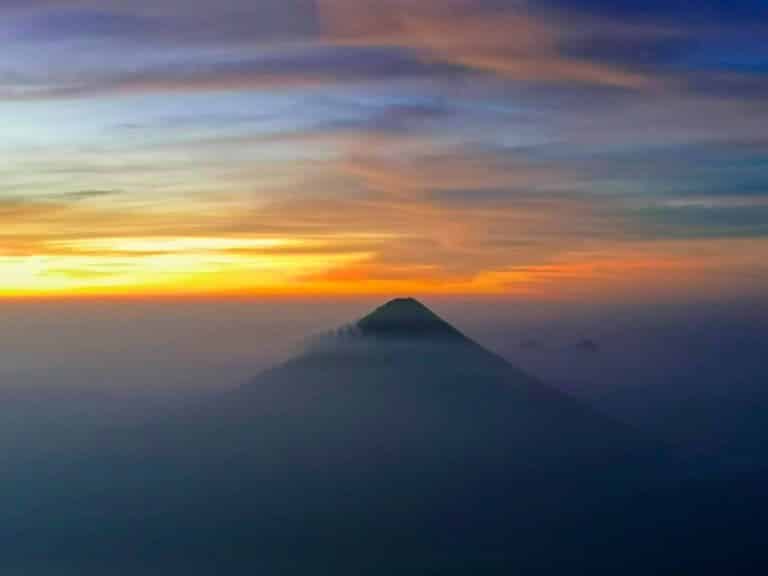
Sunrise over Volcan Agua on the 4am hike to the summit of Acatenango
ACATENANGO HIKE: WEATHER & BEST TIME TO HIKE
WHEN IS THE BEST TIME TO HIKE ACATENANGO?
Everyone will tell you that the best time to hike Acatenango is during the dry season. This is typically between the months of November to April.
Climbing the volcano during the dry season increases the likelihood that you’ll have fewer clouds and less rain. This means you’ll have unobstructed views of Fuego erupting and hopefully stay dry on your hike too! But good weather (and good views!) can never be guaranteed. Not with climate change, not in the tropics and especially not at 3700 metres altitude.
We hiked Acatenango in June (wet season!), and had perfect weather. It was overcast during the ascent, and the top of Volcan de Fuego was hiding in the clouds when we reached base camp, but we soon got some clear views. As we hiked closer to Fuego, we were lucky enough to have a cloud inversion, creating a floor of fluffy clouds with some of the highest volcanoes poking their heads through. It felt so dreamy!
If you’re in Antigua and the weather looks okay, I’d recommend the Acatenango volcano hike regardless of the season. You never know what the views will be like, and you may be surprised! If you have the luxury of time, you can check the weather forecast for Acatenango here to maximise your chance of good weather.
Remember: The weather and volcanic activity are up to Mother Nature. There is never a guarantee of good conditions or volcanic eruptions.
WEATHER ON ACETENANGO
The Acatenango hike has varying weather along with wildly varying temperatures to match. We began our hike under the blazing hot sun, and experienced misty clouds with a little rain for the ascent, followed by clear views at the top.
Bad weather is possible year-round. In the rainy season (May to October) the rain can really dampen your spirits. But that doesn’t mean you’re guaranteed perfect weather in the dry season either (November to April)
At the top, there are normally only two weather conditions. You’ll either be in the clouds (fog) or above them (no fog). No matter what the weather is doing, it’ll be absolutely freezing.
HOW COLD IS THE ACATENANGO HIKE?
So, you’ve heard other travellers saying that the Acatenango hike in Guatemala is absolutely freezing too? They’re not wrong!
It might be warm at the trailhead. But due to Acatenango’s elevation of 3976m, it is cold all year round in the upper parts of the volcano. You’ll feel the chill even more once the sun sets, and the sky begins to darken.
If you’re anything like us, you’ll want to stay out in the evening to watch the volcano erupt. This means that you should bring as many layers as you can. At night, the temperature dropped to below freezing. We slept in every layer we’d brought: merino wool thermals, fleece jumper, light down jacket, thermal leggings, and hiking leggings on to
Top tip: don’t sleep in your sweaty clothes. We sweat to cool ourselves down. If you sleep in wet clothes you’ll wake up in the night shivering as the temperature drops.
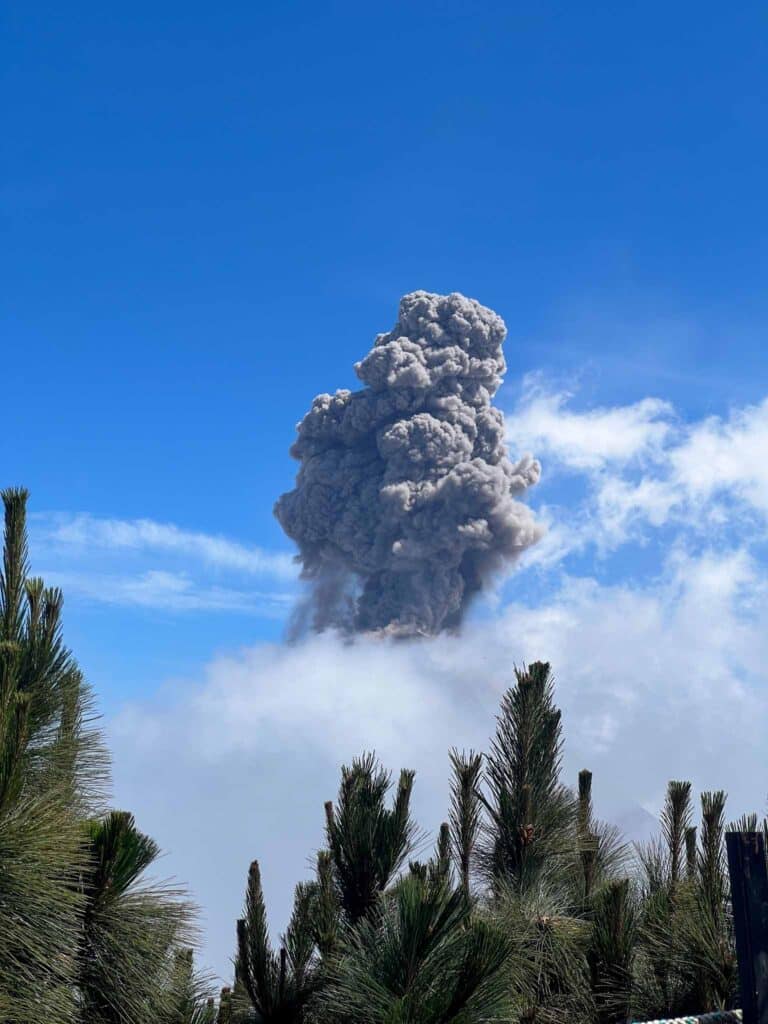
Sometimes Fuego might be hiding. That’s ok! He’ll pop out soon.
ACATENANGO HIKE: ALTITUDE & AVOIDING MOUNTIAN SICKNESS
HOW HIGH IS ACATENANGO IN GUATEMALA?
The summit of Volcan Acatenango is 3976 m above sea level, which is high enough to cause altitude sickness. If you start to feel the altitude, you may have to turn back mid-hike and if this happens you won’t get a refund.
WHAT IS THE ACATENANGO HIKE ELEVATION GAIN?
The trail starts at the dizzy heights of 2400 metres above sea level, and the base camp is around 3700 metres. This means that your elevation gain on day one will be around 1300 metres.
If you climb to the summit of Acatenango (3976 metres), your total elevation gain will be around 1550 metres over two days.
Add on the optional Fuego hike – an extra 600 metres of elevation gain – for a grand total of 2150 metres. Yep… doing the maths, I can see why my legs ached now!
THE IMPORTANCE OF ACCLIMATISATION
Altitude sickness, or acute mountain sickness, is a common illness experienced at high altitudes. It happens when travellers and hikers ascend to high altitudes too quickly, without giving their bodies time to adjust to the reduced oxygen levels. The main symptoms of AMS include headache, shortness of breath, nausea, lightheadedness, dizziness, indigestion and loss of appetite.
Altitude sickness can hit anyone at any time. It doesn’t matter how fit you are, or if you’ve avoided altitude sickness before. There’s no guarantee that it won’t affect you this time.
People respond to altitude in different ways. Whilst neither of us experienced altitude sickness on Acatenango, that doesn’t mean that you won’t (or will). In our group of twelve, only one person got mild altitude sickness. He still made it to the top of Acatenango, but he had to go a little slower than the rest of the group.
Here are our top tips to minimise your chances of getting sick at high altitudes when hiking Acatenango in Guatemala:
HOW TO AVOID ALTITUDE SICKNESS
Disclaimer: these tips are just a few things that have helped me. You should always consult a medical professional for any medical advice.
The best way to avoid altitude sickness in Acatenango, Guatemala, is to avoid going up too high, too fast. When hiking above 2000 metres above sea level, mountain guides will recommend increasing your altitude by less than 500 metres a day. But if the elevation gain for the Acatenango volcano hike is 1550 metres, that just isn’t possible on this hike!
Firstly, I’d recommend that you hike Acatenango in Guatemala after you’ve spent a couple of days in either Antigua or Lake Atitlan. Both these places have an altitude of around 1500 metres, which will give your body time to adjust.
If you’re terrible at sitting still and relaxing (me too, don’t worry), you can take a day trip from Antigua to nearby Pacaya Volcano or Hobbitenango. Both of these places at slightly higher altitudes which will help your body adjust. If you’re in Lake Atitlan, you can prepare for the Acatenango hike by hiking ‘Panajachel’ (2293 m) for panoramic lake views. All of these activities will help your body to adjust to the high altitude of Acatenango. You can also avoid heavy drinking leading up to the hike.
Once you’re on the trail, you can reduce the severity of altitude sickness by hiking slowly – it’s not a race after all. It’s really important to stay hydrated, so sip plenty of water throughout the day. You can also eat lighter meals and don’t eat too quickly. If you suffer from altitude sickness regularly, you can bring over-the-counter altitude sickness tablets (such as Diamox). But these should be used as a last resort!

Fuego sending out sparks as the sun rises on the Acatenango volcano hike
ACATENANGO HIKE: WHAT TO WEAR AND WHAT TO PACK
WHAT TO WEAR FOR HIKING VOLCAN ACATENANGO?
After you book your tour, your agency should send you a list of what you’ll need to bring. Each company is slightly different, but generally speaking, this is what you’ll need (plus our personal recommendations!)
- Hiking boots: Hiking trainers are fine – that’s what we had – but I missed my lovely leather walking boots that I left back in Scotland. Normal sports shoes will probably be ok, if that’s all you have, but fashion sneakers or converse won’t do.
- T-shirt: It will be boiling hot when you start hiking, but the higher you get, the cooler it becomes. Wear something you’re comfortable in, and bring a thin jumper for layering.
- Shorts or leggings: Again, wear something that’s comfortable for hiking in the heat but that you can layer up once you get to base camp. Zip-off trousers are perfect for this.
- Thin jumper: it can get a bit chilly when you stop for a break! Although it might be warm when you set off, have a thin jumper accessible in your backpack, just in case.
- Sun hat or bandana: not essential, but nice to have. I love to have a bandana because my head always burns.
- Sunglasses: there’s not a lot of shade in parts of the hike. Polarised ones are best, but bring what you have.
- A backpack: we travelled with only 30L backpacks plus a small day pack. A 30L backpack will be enough for everything you need for this hike!
While hiking Acatenango, the temperature will gradually drop. And up at base camp and the summit, it’s quite cold. Because of this, it’s important to bring lots of warm layers for the trek.
But Alice, I haven’t packed for cold climates?
Don’t worry, we didn’t pack for cold weather either! You can rent anything you need from your agency for a small cost. We borrowed wool hats, gloves, and trekking poles. And let me tell you, they were worth every penny. When my ears get cold, I get the worst headaches, so a wool hat was a must for me.
DO I NEED HIKING BOOTS FOR ACATENANGO?
If you have hiking boots, that would be the best option, but trainers are fine!
I wore my Vivo Barefoot hiking trainers for all our Central America hikes and they held up really well. That said, I did miss my walking boots, which I left back in Scotland (they’re heavy!)
The route up isn’t technically challenging, it’s just steep and goes uphill for a really long time. Coming back down it’s nice to have some ankle support and shoes with a good grip. On our hike, most people wore hiking trainers. Pretty much everyone slipped at some point, although luckily, no one was seriously injured.
WHAT TO PACK FOR HIKING VOLCAN ACATENANGO?
You’ll want to have some stuff in your backpack in addition to what you’re wearing. Again, your tour agency should give you a list. But here’s what we packed (or wish we’d packed!)
- Spare clothes for Day 2: A second T-shirt, another pair of leggings or trousers (unless you want to be gross and wear the same thing for 48 hours like we did), and a change of underwear
- Thermal layers: It’s cold up there at night and you’ll want something warm to sleep in. We love Seadon’s Merino wool t-shirts. Get your discount here!
- Water: There’s no running water on Acatenango, so you’ll need to bring enough for two days, even if you have a travel filter bottle!
- Extra snacks: A handful of nuts or a chocolate bar can go a long way in keeping up morale on this hike.
- Toilet roll: Self-explanatory. Any traveller to Latin America should always carry toilet paper or tissues.
- A headlamp and spare batteries: you’re going to be getting up at 3am to hike to the top of Acatenango for sunrise, and it’s going to be dark. Bring a headlamp and spare batteries!
- Electronics: Bring what you usually bring. For us that was our phone, GoPro, and battery pack. We’re a chatty pair of hikers (seriously, we don’t shut up) but if you’re a headphone-hiker, bring those too.
- Toiletries: Glasses/contact lenses, any medication, toothbrush and toothpaste, sun cream.
- Cash: Just enough to cover any surprise costs. It’s also polite to tip your guide, but it isn’t expected in the same way as it is for some hikes around the world.
Top tip: The Acatenango volcano hike in Guatemala is super popular! Leave what you don’t need back at your accommodation in Antigua, they’ll store it for you for free while you hike!

ACATENANGO HIKE: HOW FIT DO YOU NEED TO BE?
HOW LONG IS THE ACATENANGO HIKE?
In general, it’s around 7 km to the base camp and a further 2 km to the summit for a total round trip distance of 18 km (11 miles). Add a couple more kilometres if you choose to do the optional Fuego hike.
The exact distance you walk will depend on what company you go with, as the base camp locations are all slightly different.
HOW LONG DOES IT TAKE TO HIKE ACATENANGO?
The Acatenango volcano hike is usually done as an overnight trip over two days. It can be done in one day, but we’ll get to that in a minute. The overnight hike can be broken into three parts.
Part 1: Trailhead to the base camp. This is day one. It will take between five to six hours, depending on your pace.
From base camp you should already have spectacular views of Fuego. If you’re like to get even closer to Fuego, you might be able to do an optional extra hike. This will add another two to three hours of hiking on day one.
Part 2: Base camp to Acatenango summit. Weather permitting, you start to hike to summit of Acatenango early on day two (we started at 3:30 AM). This only takes a couple of hours up and down. But it is the toughest part because it is straight up, and you’re hiking through volcanic sand, in complete darkness.
It’s worth the reward: sunrise views while watching Volcan Fuego erupt. But we thought it was nothing compared to the gorgeous sunset we witnessed as we hiked closer to Fuego the night before.
Coming back to base camp is easy, just slide down the rocky slopes!
Part 3: Base camp to the trailhead. The trip back down is all downhill. It’s around two to three hours in total.
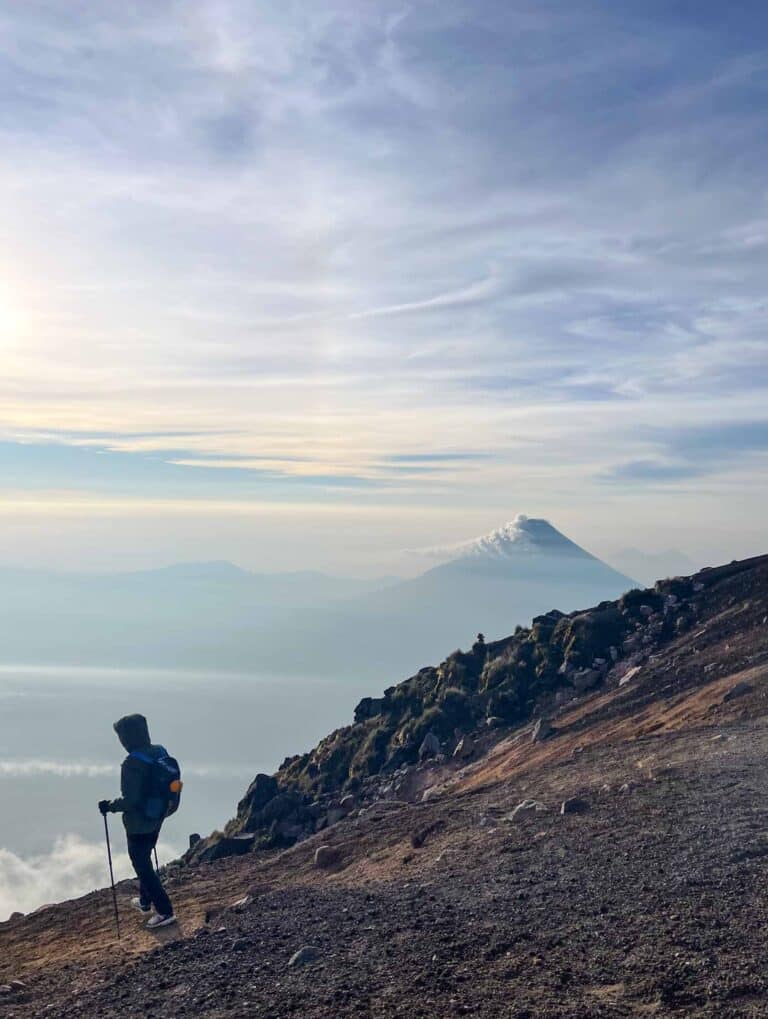
Hiking down from Acatenango’s summit
IS THE ACATENANGO VOLCANO HIKE DIFFICULT?
The Acatenango hike is hard, both physically and mentally. It’s known for wreaking havoc on experienced and inexperienced hikers alike because of it’s brutal incline.
In fact, we heard from lots of travellers (and read in many blogs) that it was the hardest and most strenuous hike of their lives. And we also have to say that it was really exhausting!
Should you still do it? Absolutely!
This hike broke me. I mean, coming back from the ‘optional Fuego hike’ (more below), I disocciated. My legs kept walking, but my brain was somewhere else. But the views were spectacular and seeing an active volcano erupt right in front of you makes you feel connected to nature in a way so few experiences do.
Have we put you off yet? We hope not! Nothing beats the feeling of getting yourself right in front of an active volcano. The views are nothing short of spectacular. And think about how proud and accomplished you’ll feel once you reach the top!
DO I NEED TO BE FIT TO HIKE ACATENANGO?
Most people who do this hike are not super active athletes or mountaineers. They’re just normal travellers. If they can do this hike, then so can you!
Hiking Acatenango will definitely be easier if you have a decent fitness level and exercise regularly. But even if you don’t, don’t let it hold you back! You should still have this amazing experience, even if you can’t describe yourself as fit. The altitude will be a challenge regardless, so if you’re generally healthy, you should be fine.
Remember, you can hike at your own pace. It’s not a race for who can do it the fastest. And you can take as many breaks as you like going up (we took breaks every 20 to 30 mins).
Hiking is more about having a positive mental attitude than about being super fit. And the Acatenango Volcano hike in Guatemala is it’s about 20% physical and 80% mental. I’m not at peak fitness, but I’ve accomplished some of the world’s most amazing hikes, mostly out of belief that I can. From Canada’s Rocky Mountains to Nepal’s Annapurna Circuit and Peru’s Machu Picchu to Morocco’s Mount Toubkal, I’ve made it to the top every time out of sheer willpower.
The key is just to just believe in yourself. So, get chatting to your travel buddies, listen to some upbeat music, share out some chocolate, and keep on putting one foot in front of the other. Nothing else matters for those few hours. You’ve got this!
DO I NEED TO TRAIN FOR THE ACATENENGO HIKE IN GUATEMALA?
If you can walk uphill for the best part of a day with a light to medium-weight backpack, you don’t need to do any extra training.
That said, it’s never a bad idea to hike up few smaller volcanoes in Central America in preparation. We recommend nearby Pacaya in Guatemala, the Santa Ana Volcano hike in El Salvador, or Cerro Negro in Nicaragua. All of these are great hikes to get used to steep slopes and volcanic terrain.
IS IT POSSIBLE TO HIRE A PORTER TO CARRY MY BACKPACK UP ACATENANGO?
Your hostel in Antigua will be able to hold on to most of your belongings for you whilst you hike Acatenango in Guatemala. You only need to bring what you need for the hike. This will make your backpack significantly lighter than the beast you’re probably used to carrying around Central America.
If you think you might struggle with carrying your bag on the hike (or just want to make your hike easier!), you can hire a porter to carry it to the top for you. The cost of a porter is between $10 to $15 USD, one way. They will carry your bag up to base camp, meet you there, and then head back down. This means you only have to carry your backpack downhill the next day.
Note: Since 2021, you can no longer ride a horse up to base camp or have a horse carry your luggage! We love this new legislation, as from what we’ve heard, the horses weren’t treated very well!

Sunrise over Volcan Agua
ACATENANGO HIKE: SAFETY
IS THE ACATENANGO HIKE SAFE?
Hiking to see an active volcano? Is this hike even safe? Well, Acatenango, the volcano you’ll be hiking up, hasn’t erupted since 1972. Since the Acatenango volcano hike has exploded in popularity, this volcano is constantly monitored for any signs of activity.
If there was any risk of Acatenango erupting, you wouldn’t be allowed to hike. Simple as that.
Volcan de Fuego, on the other hand, is the most active volcano in Central America. Clouds plume in the air, sparks light up the night sky and lava cascades down the slopes. If you choose to do the extra Fuego hike, you’ll be less than a kilometre away from this. You’ll be so close, that you’ll be able to feel the ground shake with every eruption.
But that’s kind of the point. You’re hiking because you want to to see an active volcano, right? Yes, there is an element of risk to it. But no risk, no reward.
The daily eruptions from Fuego are low-level eruptions with minimal risk. Dangerous eruptions from Fuego are relatively infrequent. The last one was in June 2018 and caught many people by surprise. But when the guides noticed signs of an eruption, they had plenty of time to get everyone off the slopes and back to Antigua.
Like Acatenango, Fuego is also constantly monitored. If there are any signs of a big eruption, companies will push pause on their tours until the danger has passed.
In terms of crime, there’s nothing to really worry about. You’ll be in a huge group on a well-trodden path, probably with groups in front and behind you. Plus the hike is seriously hard work. I can’t imagine any opportunistic criminals hanging out on the trail on the off chance that they might get to swipe your belongings.
HIKING ACATENANGO: THE ONE DAY OPTION
CAN I HIKE ACATENANGO IN ONE DAY?
Yes, it’s possible to hike Acatenango in one day, but it’s difficult.
Some tour companies in Antigua offer 1-day hiking tours. These will bring you up to the summit of Acatenango and back down, without staying overnight in base camp. I’d only recommend these if you’re pressed for time.
There are two types of one-day tours, a day-tour and a night-tour.
Let’s discuss both options for hiking Acatenango in one day in more detail…
#1 HIKE ACATENANGO IN ONE DAY: DAYTIME VOLCANO HIKE
This is the Acatenango trek to do if you’re really short on time. Your day tour will leave Antigua bright and early (around 5 am) and return to Antigua in the evening, around 12 hours later
It’s a really long day. Hiking Acatenango in one day, from 2400 metres to 4000 metres of elevation, and all the way back down again will be hard. I mean, it was hard over two days, I can’t imagine condensing it into just one!
And, you’ll only get around 30 minutes to enjoy the views from the summit. There’s no guarantee that you will get to see Fuego erupt in these 30 minutes. When we did the hike, Fuego would be fairly quiet for 20 to 30 minutes, before erupting several times in a row. Imagine if the quiet 30 minutes were your one and only chance to view Fuego’s eruption?!
For me, the best part of the trek was getting to walk closer to Fuego for sunset. The sunrise hike was also incredible; watching Fuego erupt, sending orange sparks splashing across the deep blue sky, was an awe-inspiring moment. It’s only after nightfall that you can really see the sparks and lava coming out of the volcano’s crater.
On the daytime trek, you’ll get no sunset, no sunrise, and no night-time Fuego eruption. You’ll be missing out on a lot, and not saving an awful lot of money either! Personally, I wouldn’t recommend this tour unless you absolutely can’t spare two days from your itinerary.
#2: HIKE ACATENANGO IN ONE DAY: ACATENANGO NIGHT HIKE
For a night hike, tours typically leave around 11 pm from Antigua. You’ll start hiking at around 1 am. The aim is to be at the summit of Acatenango for sunrise. After 30 to 45 minutes, it’s time to hot-foot it back down the volcano and return to Antigua all within 12 hours.
Hiking Acatenango in one day will always be a really long day. Your legs will be dead afterwards. I was exhausted just getting to base camp, never mind the extra 300 metres of elevation between base camp and the summit. This option is my idea of hell! I’m definitely not a night-time person and hiking 12 hours through the night will mess up my sleep for days!
The night hike can also be stressful as there’s time pressure to reach the top for sunrise. If you’re a slow hiker (don’t worry, I am too!), a little unfit, or haven’t coped well with hiking at altitude in the past, this probably isn’t the trek for you.
Again, there’s also no guarantee that you will get to see Fuego erupt in the 30 minutes you have at the top. He’s a fickle volcano, sometimes there are lots of eruptions, and sometimes it’s only once every few hours.
You won’t even save any time on this hike! The days before and after the hike will be a write-off as you recover and try to get your sleep pattern back. It’s also not much cheaper than the 2-day hike, but you can save a bit of money by not needing a hostel back in Antigua at least.
Honestly? We still don’t think it’s worth it.
#3 BONUS OPTION: 4WD TOUR
Got cash to splash? Really don’t want to hike at all? There’s an option for you too!
For the steep price of $295 – $495 USD per person, you can embark on an Acatenango Jeep tour. These tours are the same as the overnight tour, but you save around 3½ hours of uphill hiking, leaving a far easier trip to the summit, and giving plenty of extra time for slower hikers.
A 4WD vehicle will drive you almost all the way to base camp. Jump out of the jeep and enjoy a gentle 45 minute stroll to your tent or cabin for the night. You don’t even need to carry a backpack or anything.
I’d say that this option is only worth if if you want to see the volcano and there’s no way you’d make the hike (whether that’s due to age, fitness, illness, or physical ability). It’s insanely expensive and the experience will be mainly the same.
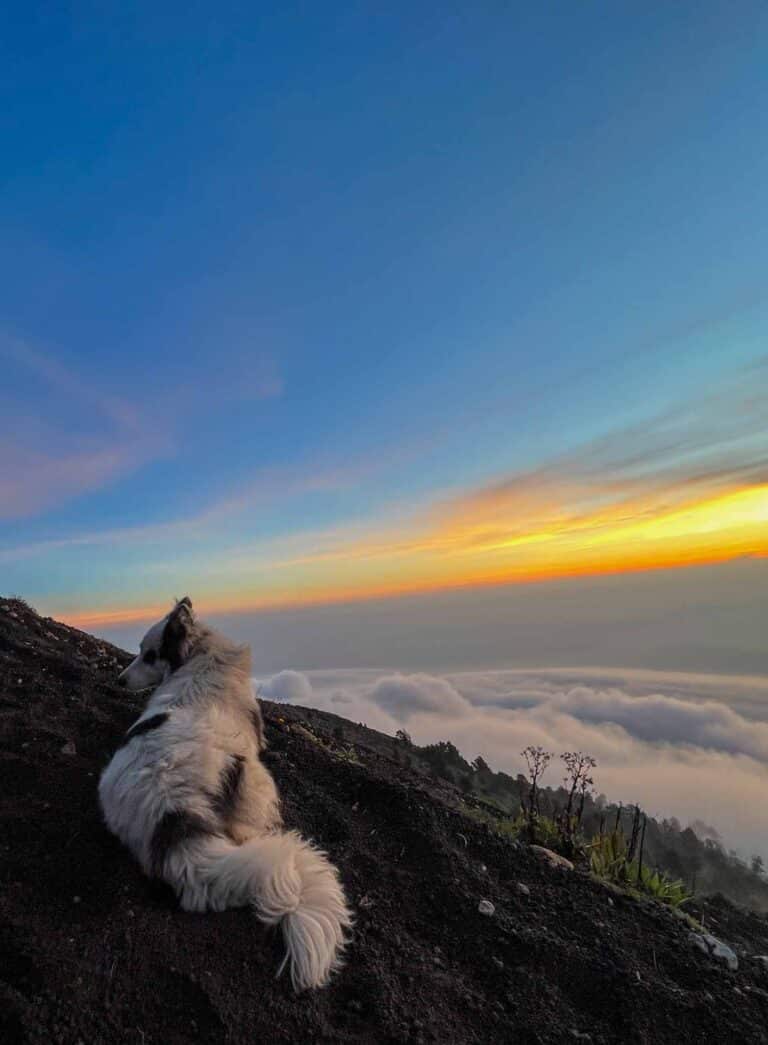
There are so many friendly dogs on the Acatenango volcano hike!
HOW TO HIKE VOLCAN ACATENANGO RESPONSIBLY
Remember to practise respect during your Acatenango trek, and your entire stay in Guatemala. You’re a guest in this country, so it’s important to respect it.
This means that during the hike, be sure to pack in and pack out. Stay on the trails, disturb as little of the land and nature as possible, and don’t leave behind your rubbish! I really recommend checking out our 7 tips for eco-conscious hikers as a good place to start.
OTHER AMAZING THINGS TO DO NEAR ACATENANGO, GUATEMALA
#1 EXPLORE THE STREETS OF ANTIGUA
Antigua is the most popular city in Guatemala, with both travellers and locals heading here for a dreamy getaway. Soak up the atmosphere with a stroll through Antigua’s UNESCO-listed historic district, and get your photo with the famous Santa Catalina Arch. You can also take a free walking tour of historic churches and convents, delving into the fascinating history of this former capital city.
But the best thing about Antigua? The FOOD. After travelling through Honduras and El Salvador, where vegetarian options were few and far between, Antigua’s foodie scene was a breath of fresh air. This little city has everything you could possibly want to eat. Local cuisine is plentiful, but there are also tons of healthy vegetarian and vegan options! They have ‘Western food’ too, if you’re craving that.
#2 ROAST MARSHMALLOWS ON VOLCAN PACAYA
Not another volcano?! Well, your legs might be crying in pain after the Acatenango hike. But volcano hiking is addictive. You’re going to want to see another one soon, we’re certain of it!
Enter, Volcan Pacaya. Like Acatenango, Pacaya is another active stratovolcano near Antigua. If you were lucky enough to have a clear day for your Acatenango hike, you might have seen it in the very distance.
So what’s special about this one? Well, firstly, your legs will be relieved to hear that you probably won’t be hiking it to the top. The Pacaya hike is just an afternoon stroll to a viewpoint. We were pretty disappointed when we realised this! But our mood was improved when our guide whipped out a bag of marshmallows, dug a hole, and began to roast them over the volcano’s natural heat. How cool is that?
#3 KICK BACK AND RELAX AT LAKE ATITLAN
Escape to the tranquillity of Lake Atitlan, cradled by volcanoes and surrounded by indigenous villages. This is the perfect place to relax after your Acatenango volcano hike. Here, you can explore little lakeside towns, such as San Juan and San Marcos (our favourite!), book a massage, and dip your toes in the crystal blue lake.
Lake Atitlan is also surrounded by indigenous villages, so it’s the perfect place to immerse yourself in their vibrant culture and appreciate the traditional Mayan customs. Head to San Marcos for a cacao ceremony, or explore the weekly Chichicastenango market!
Top tip: Although it looks idyllic, I’d be hesitant to swim in the lake itself. A lot of the waste from local communities can end up in the lake, and when we were there, everyone was getting sick!
#4 SHOP FOR SOUVENIRS AT CHICHICASTENANGO MARKET
Immerse yourself in the vibrant indigenous culture with a day trip to Chichicastenango. This bustling local market is the perfect place to grab souvenirs, but it’s also where the local people come to trade. There’s a colourful kaleidoscope of handicrafts, textiles, and fresh produce on offer. Chichicastenango is a crazy yet captivating experience we hope you won’t skip on your visit.
Plan your visit wisely as the market is only open on Thursdays and Sundays. The hours listed online are 6am-6pm, but most of the vendors will not finish setting up their shops before 9am.
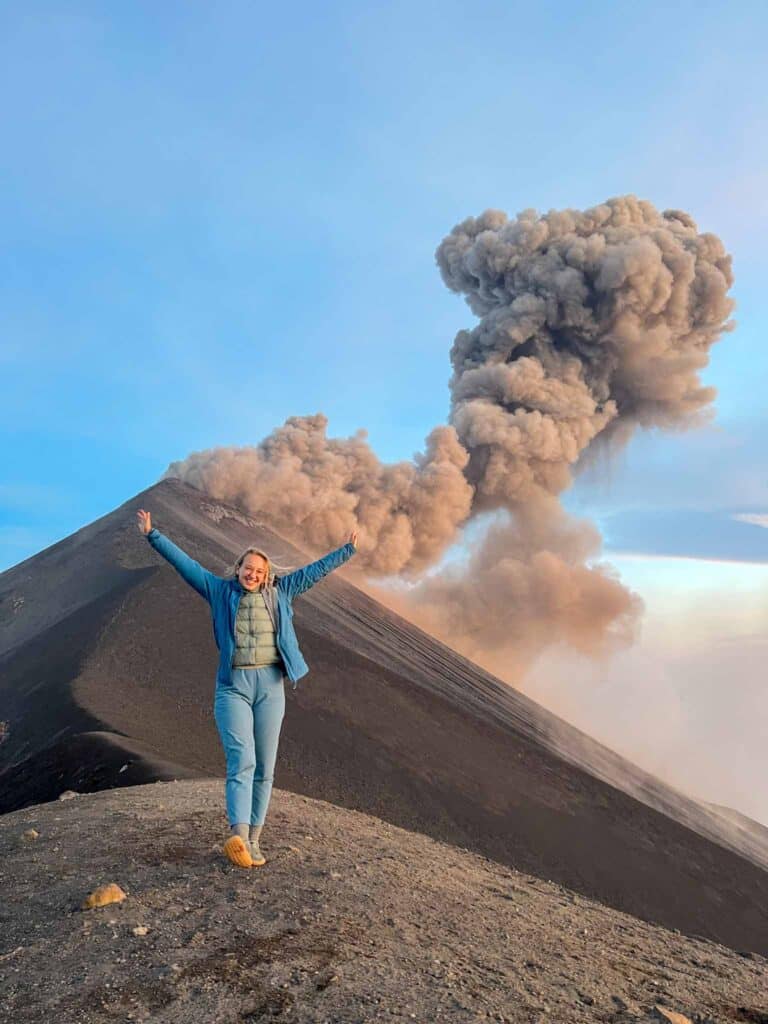
Smiles all round. You, too, could be this happy on the Acatenango Volcano hike!
IS THE ACATENANGO HIKE WORTH IT?
Absolutely. Yes. 100%.
This is possibly the best hike and toughest hike of my life but it was worth every minute of the struggling uphill. Despite almost crying several times on this hike, given the chance, I would choose to do it again every time.
We were incredibly lucky, especially considering that we hiked in the wet season. The weather was mostly alright and the views were incredible: Fuego really put on a show for us. It was a truly unforgettable experience.
If you are wondering whether this hike is for you, my answer would be yes. Don’t skip it! You’ll regret missing out on this epic experience.
We hope you found this guide useful and that we’ve inspired you to give Acatenango a go during your travels to Guatemala. If you have any questions about hiking Acatenango or if you want to share your experience with us then please leave a comment below. As always, we would love to hear from you!
LIKE IT? PIN IT!
SAVE THIS GUIDE TO YOUR GUATEMALA PINTEREST BOARD SO YOU CAN FIND IT LATER!
Follow our daily adventures on Facebook and Instagram
Disclaimer: The information and advice provided in this blog are the author’s opinions and based on their personal experiences. All information was accurate at the time of writing. However, things can change quickly, so always double-check current conditions and guidelines before setting out. Remember, your travels and safety are your own responsibility, and this blog can not be held responsible for anything that might happen on your adventures! Always exercise caution and good judgment. Oh, and don’t forget to get travel insurance! Happy travels!
This post may contain affiliate links (yay for transparency!) This means that I will earn a small commission, at no additional cost to you, if you click the link and choose to buy the product. I only link to stuff I have personally bought and found useful and never endorse crap. Your support helps keep the site going, thank you!
Alice
Alice is a UK travel blogger who advocates sustainable travel and being more eco-conscious on a budget. She loves coffee, her houseplants and summiting mountains.
You May Also Like
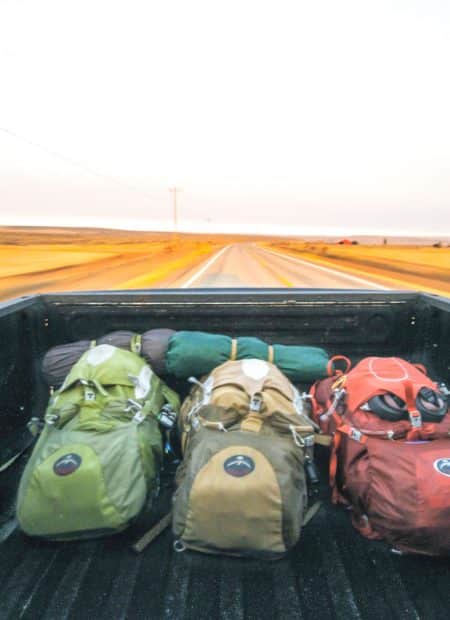
The eco-friendly travel packing list for backpackers [2023]
March 15, 2023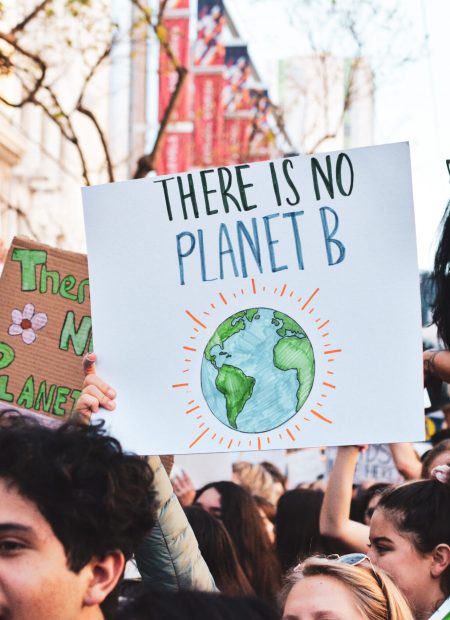
Voluntourism: Does it do more harm than good?
November 24, 2023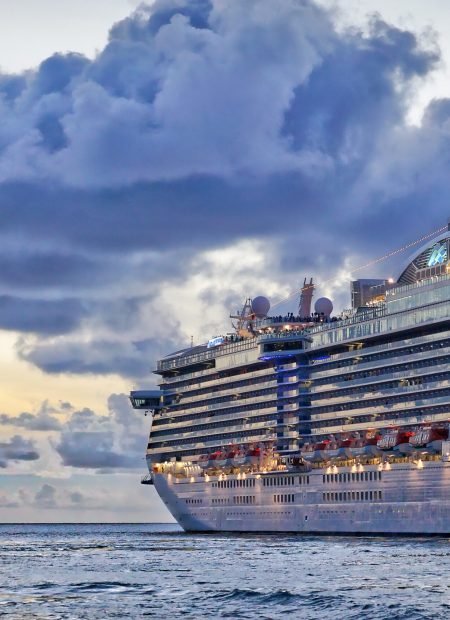
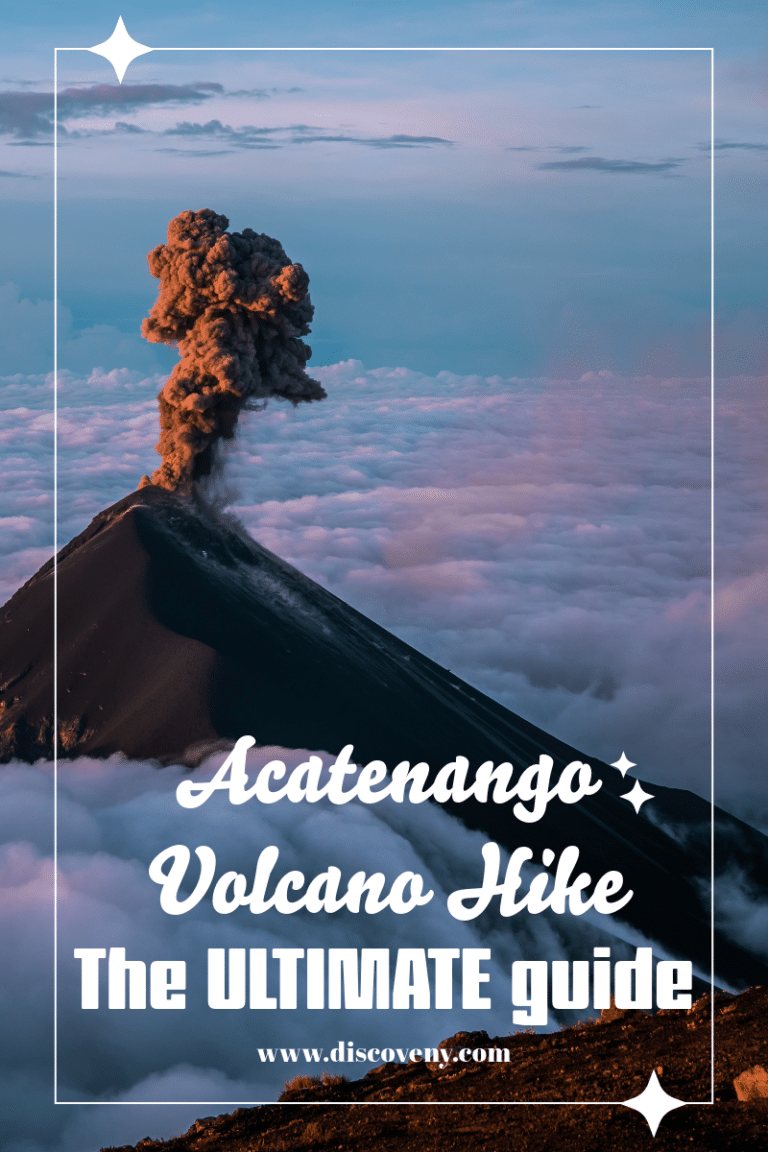

4 Comments
Gretchen
Hi, loved your article! Thank you for all the insight and tips.
Just had a question about acclimating to the elevation. We would be flying in one night getting in around 8:30pm and sleeping in Antigua then getting up the next morning to hike Acatenango. We’re a group of fairly athletic people in our late 20s, but some coming from sea level. What are you thoughts on this? Would this be doable?
Alice
So glad you found it helpful and hope you have a great trip! Acatenango is just under 4000m in altitude so it’s definitely something to be aware of, and some people on our hike were feeling the effects. It can affect anyone at any age or fitness level, even if you’ve been fine before (e.g I was fine hiking in Nepal, but was feeling very dizzy when hiking around Cusco, Peru).
Obviously the longer you can acclimatise the better, and remember, most overnight tours will sleep on the mountain, which gives you another night to get used to the altitude. If you’re worried, try and book a tour where the guides are trained to deal with mountain sickness and carry oxygen in case of emergency. Remember, on any altitude hike, it’s really important to listen to your body and descend if you’re not feeling well (even if that means you don’t make it to the top). This isn’t medical advice, and I’d always advise chatting with a medical professional, either at home before you go, or in Antigua.
Lyttu
Hey, thank you for this detailed article, it’s very helpful!
I’ll be in Antigua in June, also during the rainy season. For that reason, I think I’m not going to book anything in advance. I just have one full day in Antigua before hiking Acatenango.
If I understand, you didn’t book anything either? Do you think it’s hard to find a tour for the next day?
Thanks in advance !
Alice
Hey! Yes you can absolutely just turn up and book spontaneously. There are so many tour operators and they all run basically the same trip for the same price, so you’re sure to be able to squeeze on a next-day trip, especially in the low season! Have an amazing time – I’m jealous!